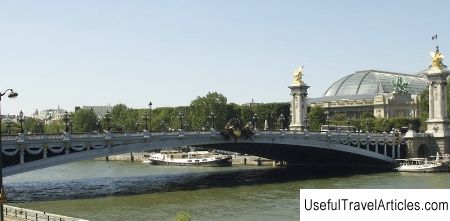Les Invalides description and photos - France: Paris
Rating: 8,5/10 (543 votes) 
Les Invalides description and photos - France: Paris. Detailed information about the attraction. Description, photographs and a map showing the nearest significant objects. The title in English is Les Invalides. Photo and descriptionThe House of Invalids is one of the most magnificent architectural ensembles in Paris, connected by a 500-meter esplanade with the Alexander III bridge. The history of this treasure began with an almshouse for war veterans. Until the 17th century, crippled and aged soldiers eked out a miserable existence in France. In 1670, Louis XIV, striving to strengthen the army, approved a plan for the construction of a charity house for retired soldiers. The project was developed by the court architect Liberal Bruant. On the suburban plain of Grenelle a huge building with a majestic facade 196 meters long and a whole town of barracks with a closed system of courtyards have grown. The largest of these, the Courdoner, was intended for military parades. The talented Jules Hardouin-Mansart helped the elderly Bruant build a chapel for veterans. Soon, Louis XIV ordered a personal royal chapel to be erected in the complex, and Mansart, inspired by the Roman Basilica of St. Peter, created a true masterpiece. In the center of the ensemble there is an amazing classicism church. Its gilded striped dome, 27 meters in diameter, rises to a height of 107 meters. The central part of the facade of the Cathedral of St. Louis is highlighted by Doric columns, on the second tier - by Corinthian ones. The portico is crowned with statues of Louis IX and Charlemagne. Inside the church, attention is drawn to a huge domed fresco by Charles de La Fossa depicting Saint Louis laying his sword at the feet of the Savior. The construction of the complex was completed in 1676 and housed four thousand veterans. Life in the town proceeded according to strict regulations - disabled people, brought together in companies under the command of officers, worked in workshops (shoe, tapestry, engraving). In 1789, the revolution in Paris began with a crowd attacking the House of Invalids in search of weapons - the veterans themselves opened the gates. In 1804, Napoleon presented the first Orders of the Legion of Honor to the officers at a magnificent ceremony. Gradually the House of Invalids also acquired the features of a museum. In 1777, a collection of models of cities and fortresses moved here (now the Museum of Plans and Reliefs), in 1905 the Army Museum was created, there is also a Museum of the Order of the Liberation (dedicated to World War II and Charles de Gaulle). Architectural ensemble plays the role of a national military pantheon: it is here that Napoleon's tomb is located. In the crypt of the cathedral rests the tomb of the emperor, carved from Russian red quartzite. Many famous French commanders are buried in the House of Invalids: the Viscount de Turenne, Ferdinand Foch, Philippe Leclerc, Jean de Lattre de Tassigny. Next to them is the author of the Marseillaise, Rouget de Lisle, and the heart of the great military engineer Marquis de Vauban. The sparkling dome of the House of Invalids has become one of the main landmarks of Paris. Tourists are attracted by the brilliant architecture, the unusual interior of the cathedral with the flags of France from different eras hung in the nave, and the captured guns displayed opposite the Place des Invalides. However, the complex is not only a museum: about a hundred veterans live here under the supervision of the State Institute of Disabled Persons. Viscount de Turenne, Ferdinand Foch, Philippe Leclerc, Jean de Lattre de Tassigny. Next to them is the author of the Marseillaise, Rouget de Lisle, and the heart of the great military engineer Marquis de Vauban.The sparkling dome of the House of Invalids has become one of the main landmarks of Paris.       We also recommend reading Remains of the Mycenaean Acropolis in Midea (Acropolis of Midea) description and photos - Greece: Argos Topic: Les Invalides description and photos - France: Paris. |




